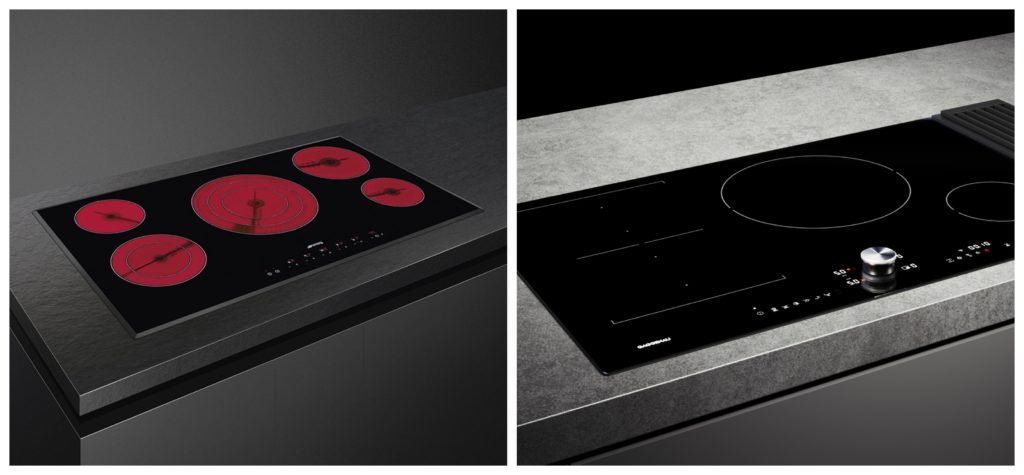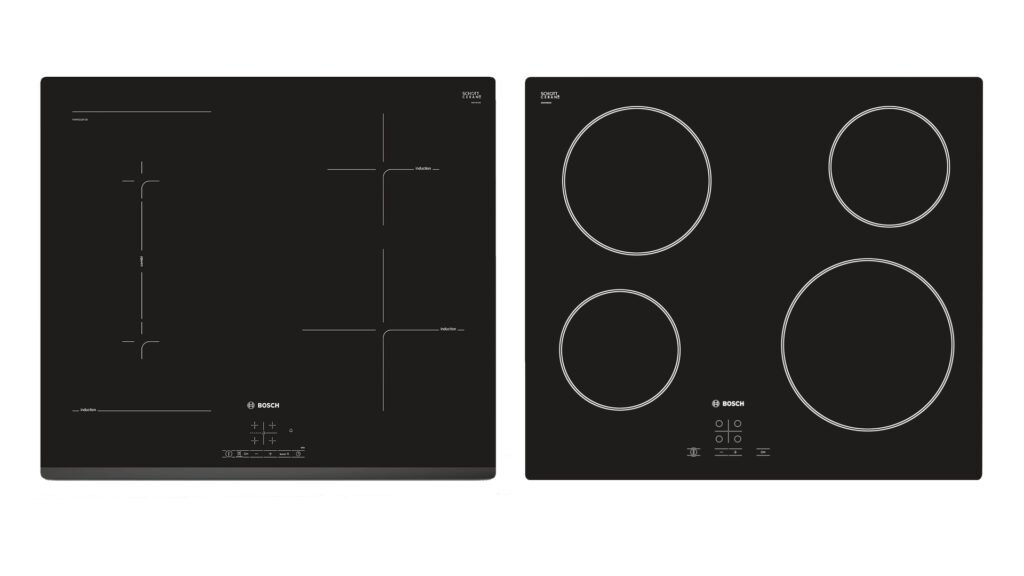
Are you in the market for a new cooktop but feeling overwhelmed by the countless options available? Look no further, as we have got you covered with this article comparing ceramic and induction cooktops. Discover the key differences between these two popular choices and find out which one is the perfect fit for your cooking needs. Whether you’re a seasoned chef or an occasional home cook, understanding the features and benefits of each option will help you make an informed decision that will enhance your culinary experience. So, let’s dive right in and explore the world of ceramic and induction cooktops!

This image is property of www.lacuisineinternational.com.
Heat Source
Ceramic Cooktops
Ceramic cooktops are a popular choice for many households due to their sleek and modern appearance. They are powered by electricity and use radiant heat to cook your food. The smooth surface of the cooktop is made of tempered glass, which allows for easy cleaning and adds a touch of elegance to your kitchen.
Induction Cooktops
On the other hand, induction cooktops have been gaining popularity in recent years due to their advanced technology and efficient cooking capabilities. Unlike ceramic cooktops, induction cooktops use electromagnetism to generate heat. When a compatible pot or pan is placed on the cooktop, an electric current is induced in the pan’s metal base, which then heats up and cooks the food.
Cookware Compatibility
Ceramic Cooktops
When it comes to ceramic cooktops, it is important to use the right type of cookware for optimal performance. Flat-bottomed pots and pans made of materials such as stainless steel, aluminum, or cast iron are suitable for ceramic cooktops. It is crucial to avoid using cookware with a rough or uneven bottom, as this can scratch or damage the ceramic surface.
Induction Cooktops
Induction cooktops, on the other hand, require specific cookware that is magnetic in nature. This means that pots and pans made of materials such as stainless steel or cast iron are suitable for induction cooking. Aluminum and copper cookware, unless specifically marked as induction compatible, will not work on induction cooktops. The use of magnetic cookware ensures efficient heat transfer and precise temperature control.
Induction Technology
How Induction Cooktops Work
Induction cooktops employ a fascinating technology that relies on electromagnetism. Underneath the ceramic surface, there are coiled copper wire elements that generate a magnetic field when electricity is passed through them. When a magnetic pot or pan is placed on the cooktop, the magnetic field induces an electric current in the cookware’s base, creating heat.
Benefits of Induction Technology
Induction technology offers several advantages over conventional cooking methods. Firstly, induction cooktops heat up significantly faster than ceramic cooktops, providing you with instant heat to start cooking immediately. Additionally, the heat produced on an induction cooktop is incredibly precise, allowing for accurate temperature control and preventing overheating or burning of your food. Induction cooktops also cool down quickly once the cookware is removed, reducing the risk of accidental burns.
Heat Distribution
Even Heating on Ceramic Cooktops
One of the advantages of ceramic cooktops is their ability to distribute heat evenly across the cooking surface. The radiant heat generated by the electric elements is transferred to the bottom of the cookware, ensuring that your food cooks uniformly. This even heat distribution is especially beneficial when preparing dishes that require consistent temperature throughout the cooking process, such as simmering sauces or slow cooking stews.
Precise and Instant Heat on Induction Cooktops
Induction cooktops excel in providing precise and instant heat. The magnetic induction process allows for immediate heat transfer to the cookware, reducing the time it takes to bring a pot of water to boil or to heat up a skillet. The heat is also evenly distributed across the bottom of the cookware, ensuring that your food cooks uniformly. This precise control over the heat makes induction cooktops ideal for delicate cooking techniques like sautéing, searing, or making delicate sauces.

This image is property of cdn.mos.cms.futurecdn.net.
Safety Features
Ceramic Cooktops
Ceramic cooktops are designed with safety in mind. They typically feature a residual heat indicator, which alerts you if the surface is still hot after cooking. This indicator helps prevent accidental burns. Additionally, many ceramic cooktops have a child lock function that prevents children from turning on the cooktop or adjusting the heat settings, adding an extra layer of safety for families with young children.
Induction Cooktops
Induction cooktops also come with a variety of safety features to ensure worry-free cooking. Most induction cooktops have a pan detection feature, which automatically detects if a compatible pot or pan is placed on the cooktop. It will not heat up unless a suitable pot or pan is present. Induction cooktops also have a built-in auto shut-off feature, which turns off the heat after a certain period of inactivity, providing peace of mind and preventing accidents.
Cleaning and Maintenance
Ceramic Cooktops
Cleaning a ceramic cooktop is relatively straightforward. The smooth glass surface makes it easy to wipe away spills and splatters with a damp cloth or sponge. However, it is important to avoid using abrasive cleaners or scrub brushes as they can scratch the surface. Regular maintenance involves removing any burnt-on or stubborn stains using specialized ceramic cooktop cleaners to keep the surface looking shiny and pristine.
Induction Cooktops
Cleaning an induction cooktop is also a breeze. Since the heat is generated directly in the cookware, spills and splatters are less likely to bake onto the surface. A quick wipe with a damp cloth or sponge is usually sufficient for day-to-day cleaning. For more stubborn stains, a mild cooktop cleaner can be used. It is important to note that while the surface of an induction cooktop does not get as hot as a ceramic cooktop during cooking, it may retain some residual heat, so caution should be exercised during cleaning.

This image is property of static.appliancesconnection.com.
Energy Efficiency
Ceramic Cooktops
Ceramic cooktops are known for their energy efficiency. The radiant heat generated by the electric elements is transferred directly to the cookware, minimizing heat loss and ensuring that the energy is used effectively for cooking. This efficient heat transfer also means that the cooktop cools down relatively quickly after cooking, reducing the need for prolonged cooling periods.
Induction Cooktops
Induction cooktops are highly energy-efficient compared to other cooking methods. The electromagnetism used in induction technology allows for precise and rapid heating, reducing the amount of time required to cook your food. Additionally, since heat is generated directly in the cookware, there is minimal heat loss, making induction cooktops more energy-efficient than gas or electric cooktops.
Cooking Performance
Ceramic Cooktops
Ceramic cooktops provide reliable and consistent cooking performance. The even heat distribution ensures that your food cooks uniformly, and the precise temperature control allows for accurate cooking. Whether you’re simmering a delicate sauce, frying crispy chicken, or boiling pasta, ceramic cooktops can handle a variety of cooking tasks with ease.
Induction Cooktops
Induction cooktops offer exceptional cooking performance. The precise and instant heat allows for precise temperature control and quick cooking times. From searing steaks to achieving the perfect simmer, induction cooktops provide the control and speed that professional chefs and home cooks alike appreciate. The ability to adjust the heat instantly and precisely makes it easier to experiment with different cooking techniques and achieve excellent results every time.

This image is property of www.homestratosphere.com.
Price Range
Ceramic Cooktops
Ceramic cooktops generally fall into a more affordable price range compared to induction cooktops. Depending on the brand and features, ceramic cooktops can range from budget-friendly options to higher-end models with added functionalities. The affordability of ceramic cooktops makes them a popular choice for those on a tighter budget or for those who prefer a more traditional cooking experience.
Induction Cooktops
Induction cooktops tend to be more expensive than their ceramic counterparts. The advanced technology and precision control come at a higher price point. However, the long-term energy savings and superior cooking performance may justify the higher investment for those who value efficiency and convenience in their cooking experience.
Conclusion
In conclusion, both ceramic and induction cooktops have their own unique advantages and considerations. Ceramic cooktops offer even heat distribution, reliable performance, and a more affordable price range. On the other hand, induction cooktops provide rapid and precise heat, energy efficiency, and superior cooking performance at a higher price point. Ultimately, the choice between the two depends on individual preferences, budget, and cooking needs. With this comprehensive comparison, you can make an informed decision and choose the cooktop that best suits your culinary adventures in the kitchen. Happy cooking!

This image is property of www.senz.com.my.






